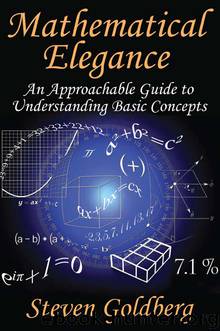Mathematical Elegance by Steven Goldberg

Author:Steven Goldberg [Goldberg, Steven]
Language: eng
Format: epub
ISBN: 9781412855136
Publisher: Transaction Publishers
It Looks Random
Random numbers play a crucial role in science. Like “time,” “cause,” and other basic conceptions of the constituents of reality, the meaning of “random” seems too obvious to require thought—until we think about it.
When we think of random numbers, we think of numbers that possess no pattern, sequences for which we can do no better than guessing when we predict the next number in the sequence. So, for example, it must be true of such a number that each digit tends to appear about one-tenth of the time (in no predictable order), each pair of digits about one-hundredth of the time (if this is not the case, then there is a patterned bias built in). A number with this quality is called “normal.” (Note that no rational fraction possesses this quality because such fractions always repeat: 1/3 is 0.3333 …, and 1/97 seems random for 96 digits and then keeps repeating those 96 digits. Also, the constraints we have mentioned must take into account the number of digits in the string; a string of ten digits is clearly not likely to be random if it is 2222222222. However, in a string of a quadrillion digits, 222222222 will appear many times.)
However, there is another quality that we tend to automatically associate with randomness: not merely is there no pattern, but there is no easy algorithm. Thus, while pi has no pattern (at least that we can discern in pi’s first billion digits), the sequence is generated by an easy rule (an algorithm for pi), and this enables us to predict every digit.
The two forms of “randomness” are in conflict. As Martin Gardner suggests, write down ten one-digit numbers. If you wrote down any number more than once, the sequence fails to meet the first criterion (i.e., it is biased toward the number you wrote down more than once). However, if you write each number just once, you satisfy the first criterion, but fail to meet the second (because, given nine digits, one can predict the tenth). This sort of conflict is inherent in all attempts at randomness, and there is no such thing as a sequence that meets both criteria.
There is, in other words, a limit precluding our attaining that which we tend to assume is true of what we mean by “random.”
Download
This site does not store any files on its server. We only index and link to content provided by other sites. Please contact the content providers to delete copyright contents if any and email us, we'll remove relevant links or contents immediately.
Modelling of Convective Heat and Mass Transfer in Rotating Flows by Igor V. Shevchuk(6391)
Weapons of Math Destruction by Cathy O'Neil(6139)
Factfulness: Ten Reasons We're Wrong About the World – and Why Things Are Better Than You Think by Hans Rosling(4691)
Descartes' Error by Antonio Damasio(3229)
A Mind For Numbers: How to Excel at Math and Science (Even If You Flunked Algebra) by Barbara Oakley(3217)
Factfulness_Ten Reasons We're Wrong About the World_and Why Things Are Better Than You Think by Hans Rosling(3197)
TCP IP by Todd Lammle(3131)
Fooled by Randomness: The Hidden Role of Chance in Life and in the Markets by Nassim Nicholas Taleb(3043)
Applied Predictive Modeling by Max Kuhn & Kjell Johnson(3018)
The Tyranny of Metrics by Jerry Z. Muller(3000)
The Book of Numbers by Peter Bentley(2907)
The Great Unknown by Marcus du Sautoy(2645)
Once Upon an Algorithm by Martin Erwig(2598)
Easy Algebra Step-by-Step by Sandra Luna McCune(2577)
Lady Luck by Kristen Ashley(2528)
Practical Guide To Principal Component Methods in R (Multivariate Analysis Book 2) by Alboukadel Kassambara(2497)
Police Exams Prep 2018-2019 by Kaplan Test Prep(2482)
All Things Reconsidered by Bill Thompson III(2354)
Linear Time-Invariant Systems, Behaviors and Modules by Ulrich Oberst & Martin Scheicher & Ingrid Scheicher(2331)
